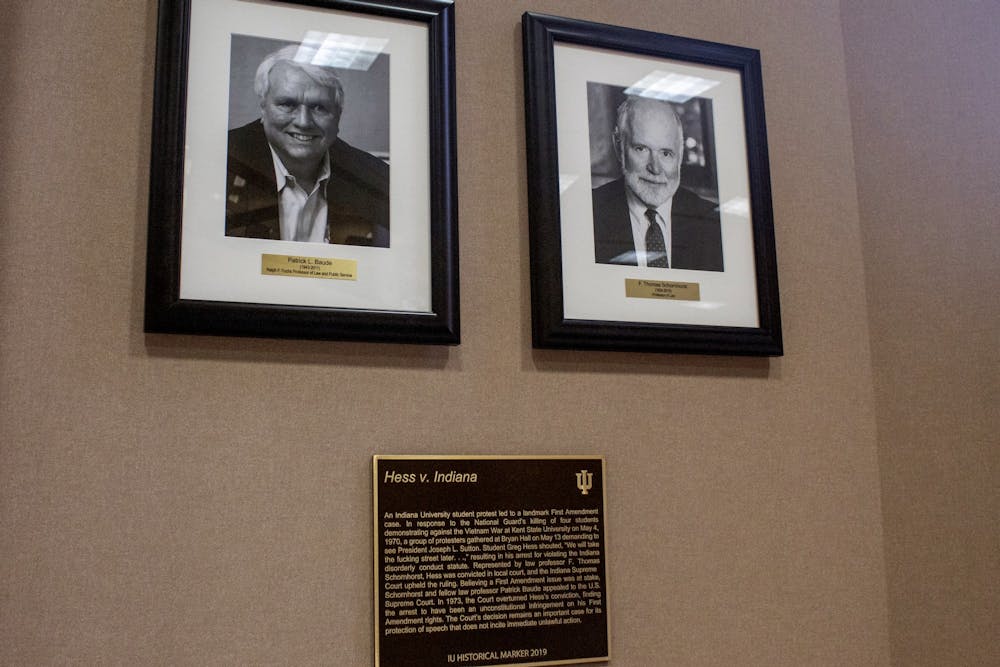In May 1970, a week after the Kent State shootings, a group of IU students gathered outside what is now the Sample Gates to protest the Vietnam War.
When police showed up to clear the area, one student named Greg Hess yelled, “We’ll take the fucking street later,” starting a chain reaction that resulted in the landmark U.S. Supreme Court decision Hess v. Indiana.
On Nov. 11, a marker was put up in the Jerome Hall Law Library dedicated to this historic Bloomington event. Law Library Director Linda Fariss, who is a member of the bicentennial historical markers committee, said she helped nominate Hess v. Indiana for a marker because it is a rare moment in history where Bloomington was in the spotlight of a national issue.
“It always stuck out in my mind because it’s a wonderful story,” Fariss said. “This was an important event that happened at the university’s campus that led to a decision at the U.S. Supreme Court on First Amendment rights.”
After Hess’ arrest, IU law professors Tom Schornhorst and Pat Baude took on the case pro bono, and after losing at local and state level courts, the professors appealed to the U.S. Supreme Court. Three years later in 1973, the court ruled 6-3 in favor of Hess, creating a precedent that continues to protect free speech, even when it threatens future lawless action.
“It was a $25 fine which I think was reduced to $1 for disorderly conduct,” Fariss said. “But this student hadn’t done anything wrong. Professor Schornhorst and professor Baude thought this was important.”
Austen Parrish, dean of the Maurer School of Law, said the marker is distinct because it commemorates an event rather than a specific person.
“Here’s an event that occurred right at our doorsteps, just right outside what’s now the Sample Gates, and it went ahead and stood for a really important legal principle,” Parrish said. “Through humble beginnings here in Bloomington, somebody through the help of faculty members left a mark on the country in a much broader way.”
Joseph Tomain, senior fellow at the Maurer School, said while this is a lesser known landmark case, it is important because it upholds First Amendment rights. During a tumultuous time in U.S. history, Hess upheld similar Supreme Court decisions like Brandenburg v. Ohio in 1969, which stated that speech had to clearly incite likely, imminent lawless violence in order for it to be criminal.
“I think that even though it’s not as discussed as other cases, it’s still a very significant case because it did protect free speech rights in very difficult times,” Tomain said.
Fariss said this story is important because it shows faculty and students working together.
“They just felt like something bad was happening, and they wanted to help,” Fariss said. “That’s what I want people to remember — this sense of justice.”
Parrish said this is one instance where Bloomington had a larger effect on national law, and it is important to commemorate that.
“Sometimes you may talk to somebody who’s in New York or Washington, D.C., and they think that Bloomington is somewhere in between cornfields,” Parrish said. “It’s nice to remind people that there’s actually some amazing things that happen here.”
Tomain said he appreciates that IU has a history of supporting First Amendment rights even in times like the Hess case when it is difficult. He cited the recent backlash against professor Eric Rasmusen as a current example of IU keeping First Amendment rights a top priority.
“I am very thankful to be at a university that protects the First Amendment in very difficult times,” Tomain said. “I strongly support Provost Robel’s email statement today saying that the First Amendment protects his right to engage in such horrific speech on Twitter, and that as a public institution he cannot be terminated for exercising his free speech rights.”
Additional historical markers dedicated to IU’s bicentennial will continue to be constructed around all IU campuses through the end of the year.



